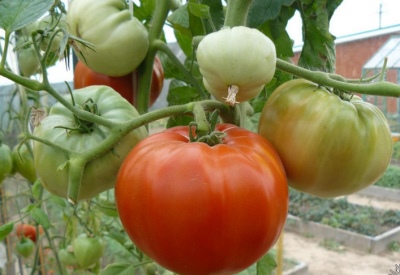
- Authors: LLC Agrofirma 'Demetra-Siberia'
- Year of approval: 2007
- Category: grade
- Growth type: indeterminate
- Appointment: fresh consumption, for pickling and preserving, for juice, for ketchup and tomato paste
- Ripening period: mid-season
- Ripening time, days: 110-115
- Growing conditions: for open ground, for film greenhouses, for closed ground
- Bush size: tall
- Bush height, cm: 150-170
Altai masterpiece tomatoes can be grown on almost any well-drained soil type. A good supply of organic matter can increase yields and reduce production problems.
Description of the variety
This variety is indeterminate, it is planted both in open and closed soil, and under a film. Bushes reach 150-170 cm, therefore, the described variety is classified as tall. He needs both a garter and shaping. The foliage grows large, its shade is light, green.
The fruits of the Altai masterpiece can be served fresh to the table, they are widely used for canning, as well as the production of ketchup, tomato paste and juices.
The main qualities of the fruit
In an immature state, the fruits of the Altai masterpiece are green, the color of the stalk is more intense. When ripe, they turn red. Poured up to a mass of 500 grams. There is a strong ribbing, the shape is flat-round.
Tomatoes of the described variety are resistant to cracking when overripe.
Taste characteristics
The Altai masterpiece tomatoes are pleasant to taste, the pulp is juicy, medium density, quite fleshy.
Ripening and fruiting
This variety belongs to the mid-season. Fruits ripen in 110-115 days. Harvesting begins in July and lasts until September.
Yield
The yield of this variety is 10 kg / m2, but this is under the film. In general, the Altai masterpiece belongs to high-yield varieties.
The timing of planting seedlings and planting in the ground
From early to mid-March, you can plant seeds for future seedlings. From mid-May to early June, it is subsequently planted in the ground.

Growing tomato seedlings is an extremely important process, because it largely depends on whether the gardener will be able to harvest at all. All aspects must be taken into account, from seedbed preparation to planting in the ground.
Landing scheme
When planting an Altai masterpiece, you should use a 60 x 50 cm scheme.

Growing and care
Some basic rules must be followed when sowing the seeds of the Altai masterpiece. Tomato seeds require a soil temperature of at least + 10 ° C to germinate. The best temperature range is between + 18 ° C and + 22 ° C, if it is higher, then there will be no seedlings.
The containers are filled with compost, one or two seeds are placed to a depth of no more than 5 cm, and then lightly sprinkled with fertile soil for another centimeter. The containers are carefully watered, covered with foil and placed on a sunny window. When the plants appear, the film is removed. Seedlings are planted when permanent leaves are formed on it.
It is advised to plant the Altai masterpiece in a garden in a sunny area and put a peg or garter cage to provide better air circulation. It is imperative to keep the seedlings free from weeds, as the presence of grass can increase moisture levels around the plants and increase the likelihood of mold growth.
As for watering, the Altai masterpiece is very picky about it. Dry soil, like waterlogging, is harmful. Timed drip irrigation is the ideal solution.
It is imperative to fertilize tomatoes, the lack of many nutrients leads to the appearance of diseases. Nitrogen is used at the beginning of vegetative growth so that the plant can quickly root and develop shoots. When inflorescences begin to appear on the branches, potassium and magnesium are added. Thanks to this, you can get a high-quality harvest.




A plant needs different micronutrients at each stage of growth. All fertilizers can be divided into two groups: mineral and organic. Folk remedies are often used: iodine, yeast, bird droppings, eggshells.
It is important to observe the rate and period of feeding. This also applies to folk remedies and organic fertilizers.
Disease and pest resistance
From rot, it is advised to use preventive measures. Avoid compacted, poorly drained soils (grow the Altai masterpiece in raised beds). Rotation, debridement, backfilling and mulching will help reduce morbidity. Fungicidal sprays with Chlorothalonil, Mancozeb or copper fungicides are great helpers in dealing with problems.
In case of an invasion of insects, such as aphids, bugs, caterpillars, it is advised to use a solution of insecticidal soap, neem oil or garlic infusion.
Anthracnose is the most common problem in this tomato variety. To reduce the likelihood of infection, do not water tomatoes over foliage, as splashing can spread fungal spores.
Since this disease also affects other plants of the Solanaceae family, the site for the Altai masterpiece should not be re-planted with nightshade plants for at least a year. Some of the weeds that infest your garden also belong to the same family, which is another reason to weed on time.
Fungal spores can remain in the soil and infect plants the next year. Mulching the garden helps create a barrier between the soil surface and the fruit, which reduces infections.


Growing regions
The central, northern, Volgo-Vyatka regions are suitable for growing the described variety. And you can also get a good harvest in Siberia and the Far East, in the south of the country and in other regions.

























































































